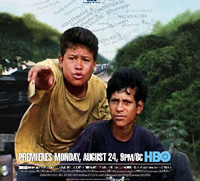![]() FPA is proud to present one of its newest bloggers, David D. Sussman, who writes for FPA’s Venezuela Blog. Below is a post by David on some movies dealing with Migration and Latin America. I encourage readers to check out FPA’s Venezuela Blog frequently. Enjoy!
FPA is proud to present one of its newest bloggers, David D. Sussman, who writes for FPA’s Venezuela Blog. Below is a post by David on some movies dealing with Migration and Latin America. I encourage readers to check out FPA’s Venezuela Blog frequently. Enjoy!
 On August 24th HBO will present a new documentary titled “Which Way Home”. This film follows a number of children, as young as 9-years old, on their perilous journey from Central America into the United States. While seeking to enter the US illegally, they dream of building better lives.
On August 24th HBO will present a new documentary titled “Which Way Home”. This film follows a number of children, as young as 9-years old, on their perilous journey from Central America into the United States. While seeking to enter the US illegally, they dream of building better lives.
The documentary was presented at the prestigious Tribeca film festival. See more at: http://www.tribecafilm.com/filmguide/41263932.html..
An article in today’s New York Times gives further description on how the director, Rebecca Cammisa, shot the film.
Regardless of where one stands on the issue of illegal migration, “Which Way Home” provides an opportunity for audiences to hear the voices of underage migrants, who make up approximately 5% of migrants passing northwards through Mexico. It reveals the personal stories of young migrants that can become lost within the polarizing public debate over immigration to the United States.
While Hollywood seems to focus on selling glitz or scoring big at the box office (how could “Transformers 2” earn over $200 million in five days?), it is nice to see movies that spread awareness of key social issues to a wider public audience. A few other flics touching on the theme of migration also come to mind:
“Tears of the Sun” (2003): Please don’t laugh. This Hollywood action movie starring Bruce Willis may not describe the complexities of refugee situations, but it does place the issue of displaced persons squarely within the film’s plot.
“Maria Full of Grace” (2004): Portrays the use of women as “mulas” (mules) to transport cocaine, ingested in latex balloons, on flights into the United States. Actress Catalina Sandino Moreno was nominated for an Oscar for her leading role.
“Human Trafficking” (2005): A TV movie revealing the exploitation of women forced into prostitution in other countries (although it could have also shown with greater depth that men and economic migrants are also at risk of being trafficked).
David D. Sussman also writes about Venezuela on FPA blogs. You can find further commentary and analysis at: venezuela.foreignpolicyblogs.com/